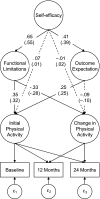Trajectory of declines in physical activity in community-dwelling older women: social cognitive influences
- PMID: 19528360
- PMCID: PMC2728090
- DOI: 10.1093/geronb/gbp049
Trajectory of declines in physical activity in community-dwelling older women: social cognitive influences
Abstract
Studies examining physical activity behavior suggest that activity levels decline with age. Such declines are particularly problematic among older adults in light of the research suggesting a protective effect of physical activity on numerous physical health outcomes associated with independent living. Despite a growing recognition of the importance of a physically active lifestyle, little is known about the role of demographic and psychosocial variables on this trajectory of change. In this study, the roles played by outcome expectations, self-efficacy, and functional limitations on changes in physical activity levels over a 2-year period in older women were assessed using latent growth curve modeling. Data were obtained from 249 community-dwelling older women (M age = 68.12, n = 81 Black, and n = 168 White). Demographic, health status, and psychosocial data were collected via self-report upon entry into the study. Self-reported physical activity was assessed at baseline and again at 12 and 24 months. As expected, physical activity declined over the 2-year period. Self-efficacy demonstrated an indirect association with the trajectory of decline in physical activity through functional limitations. Importantly, the pattern of relationships appears independent of demographic factors and chronic health conditions.
Figures


Similar articles
-
Correlates of functional fitness in older adults.Int J Behav Med. 2008;15(4):311-8. doi: 10.1080/10705500802365557. Int J Behav Med. 2008. PMID: 19005931 Free PMC article. Clinical Trial.
-
Physical activity and quality of life in older adults: an 18-month panel analysis.Qual Life Res. 2013 Sep;22(7):1647-54. doi: 10.1007/s11136-012-0319-z. Epub 2012 Nov 19. Qual Life Res. 2013. PMID: 23161331 Free PMC article.
-
Physical activity in middle-aged and young-old adults: the roles of self-efficacy, barriers, outcome expectancies, self-regulatory behaviors and social support.J Health Psychol. 2010 Mar;15(2):173-85. doi: 10.1177/1359105309342283. J Health Psychol. 2010. PMID: 20207661
-
Social cognitive influences on physical activity behavior in middle-aged and older adults.J Gerontol B Psychol Sci Soc Sci. 2012 Jan;67(1):18-26. doi: 10.1093/geronb/gbr064. Epub 2011 Jul 9. J Gerontol B Psychol Sci Soc Sci. 2012. PMID: 21743038 Free PMC article.
-
Physical activity, disability, and quality of life in older adults.Phys Med Rehabil Clin N Am. 2010 May;21(2):299-308. doi: 10.1016/j.pmr.2009.12.006. Phys Med Rehabil Clin N Am. 2010. PMID: 20494278 Review.
Cited by
-
A smartphone "app"-delivered randomized factorial trial targeting physical activity in adults.J Behav Med. 2017 Oct;40(5):712-729. doi: 10.1007/s10865-017-9838-y. Epub 2017 Mar 2. J Behav Med. 2017. PMID: 28255750 Clinical Trial.
-
Physical activity, exercise, and sarcopenia - future challenges.Wien Med Wochenschr. 2011 Sep;161(17-18):416-25. doi: 10.1007/s10354-011-0001-z. Epub 2011 Jul 29. Wien Med Wochenschr. 2011. PMID: 21792532 Review.
-
Building on Lessons Learned in a Mobile Intervention to Reduce Pain and Improve Health (MORPH): Protocol for the MORPH-II Trial.JMIR Res Protoc. 2021 Jul 19;10(7):e29013. doi: 10.2196/29013. JMIR Res Protoc. 2021. PMID: 34279241 Free PMC article.
-
Social cognitive predictors of physical activity in relapsing-remitting multiple sclerosis.Int J Behav Med. 2014 Dec;21(6):891-8. doi: 10.1007/s12529-013-9382-2. Int J Behav Med. 2014. PMID: 24407400
-
Improving physical functional and quality of life in older adults with multiple sclerosis via a DVD-delivered exercise intervention: a study protocol.BMJ Open. 2014 Dec 1;4(12):e006250. doi: 10.1136/bmjopen-2014-006250. BMJ Open. 2014. PMID: 25448627 Free PMC article. Clinical Trial.
References
-
- Bandura A. Social foundations of thought and action: A social cognitive theory. Englewood Cliffs, NJ: Prentice Hall; 1986.
-
- Bandura A. Self-efficacy: The exercise of control. New York: W.H. Freeman; 1997.
-
- Bandura A. Health promotion by social cognitive means. Health Education & Behavior. 2004;31:143–164. - PubMed
-
- Bentler PM. Comparative fit indexes in structural models. Psychological Bulletin. 1990;107:238–246. - PubMed
-
- Browne MW, Cudeck R. Alternative ways of assessing model fit. In: Bollen KA, Long JS, editors. Testing structural equation models. Newbury Park, CA: Sage; 1993. pp. 136–162.
Publication types
MeSH terms
Grants and funding
LinkOut - more resources
Full Text Sources
Medical
Research Materials

